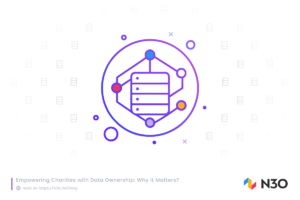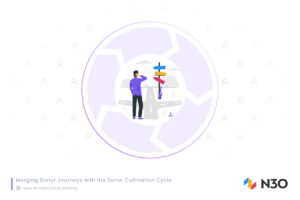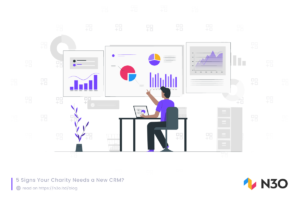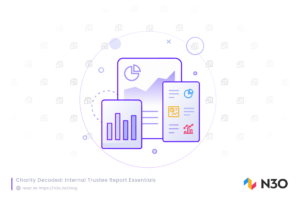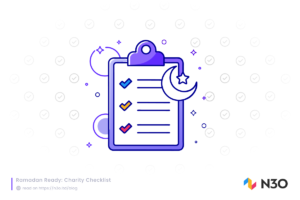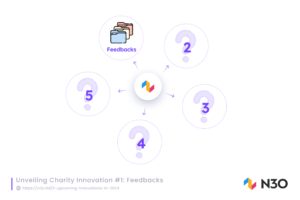Charities play a key role in building donor-beneficiary relationships, with trust as the cornerstone.
To maximise the fundraising impact, charities need to connect and build strong relations with donors. To achieve this, a strategic approach is essential. Fundraisers often come across terms such as donor cultivation cycle and donor journeys. But the real question is whether these approaches are effective for your fundraising strategy or not.
In this article, we explore each concept and propose an integrated fundraising model, merging the donor journeys with the donor cultivation cycle to achieve lasting success.
What is the Donor Cultivation Cycle?
The donor cultivation cycle is a strategic process used by nonprofits to build and maintain strong relationships with donors. Its stages are the following:
- Identification: Identify potential donors.
- Qualification: Assess their willingness and capacity to give.
- Cultivation: Build relationships through engagement and interaction.
- Solicitation: Make direct requests for donations.
- Stewardship: Acknowledge and thank donors for their contributions. Maintain ongoing communication and encourage continued and increased support.
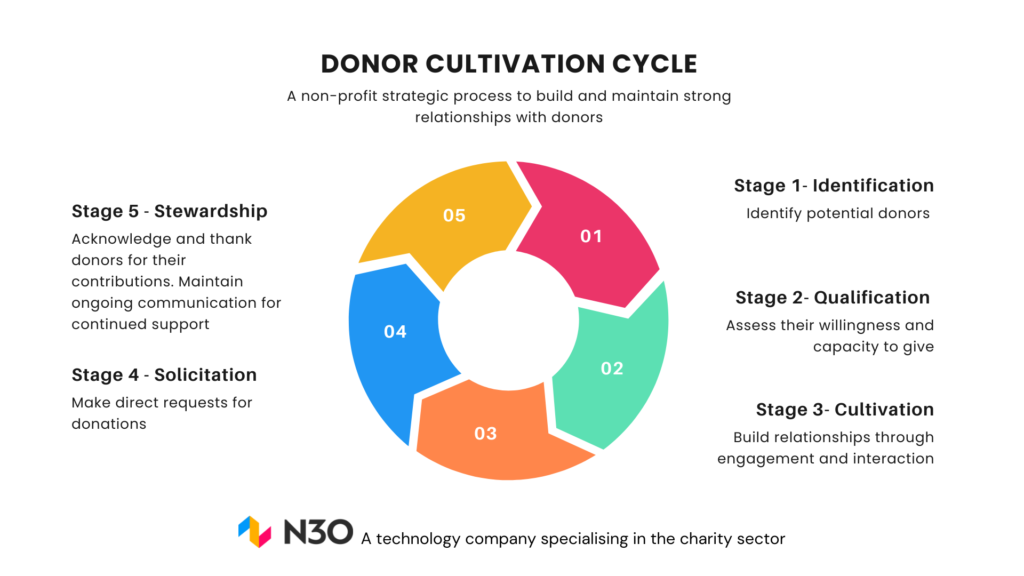
What are Donor Journeys?
Donor journeys refer to a donor’s complete experience with a nonprofit organisation, from initial awareness to long-term involvement. This journey encompasses all the interactions and touchpoints a donor encounters with a charity. Its stages are as follows:
- Awareness: The donor becomes aware of the Charity/NGO and its mission.
- Consideration: The donor explores and evaluates the organisation, deciding whether to engage further.
- Engagement: The donor starts interacting with the organisation by attending events or signing up for a newsletter.
- Giving: The donor makes a financial contribution or other form of support.
- Stewardship: The organisation nurtures the relationship, providing updates and recognition – encouraging continued involvement.
Donor Cultivation Cycle Vs. Donor Journeys
The donor cultivation cycle and donor journey are closely related to fundraising and nonprofit management. They also share several overlapping stages and goals. However, they approach these stages from slightly different perspectives and emphases.
Some argue that the donor cultivation cycle is insufficient for achieving fundraising success in today’s complex landscape. Here’s why:
1. Outdated, organisation-centric approach:
The donor cultivation cycle primarily serves organisational needs, offering a one-size-fits-all approach. It fails to consider donors’ unique and evolving expectations, leading to missed engagement opportunities.
Example: A charity uses the donor cultivation cycle to send out the same thank-you letter to all donors after a campaign. While this might meet the organisation’s need for acknowledgement, it overlooks individual donor preferences. For instance, major donors might expect a personalised phone call from a senior official, while younger donors might prefer a video message. This one-size-fits-all approach can make donors feel undervalued, resulting in lower retention rates.
2. Lack of emphasis on data and insights:
The traditional model inadequately integrates data-driven insights, leading to generalised engagement strategies. Without a deep understanding of donor demographics and interests, nonprofits risk alienating supporters and wasting resources.
Example: A nonprofit launches a fundraising campaign targeting all supporters with a generic appeal. Without analysing data, it fails to recognise that a significant portion of its donor base consists of millennials who are more motivated by specific causes like environmental sustainability. As a result, the campaign’s messaging misses the mark, leading to lower engagement and donations. By not leveraging donor data, the charity misses the chance to tailor its appeal to resonate with different donor segments.
3. Inadequate consideration of diverse acquisition channels:
The rise of digital platforms means donor engagement occurs through multiple channels, which the traditional cycle overlooks. This can result in a cookie-cutter approach that misses critical opportunities for personalised interaction.
Example: A charity continues relying heavily on direct mail and email campaigns, as the traditional donor cultivation cycle prescribes. However, they neglect social media and mobile platforms where younger donors are more active. This oversight leads to missed opportunities for engagement, as potential donors on Instagram or TikTok never see the campaign. Additionally, younger donors who prefer to give via mobile apps or social media links may find the charity’s methods outdated and inconvenient, resulting in lower participation.
These and many other missing pieces of a traditional donor cultivation approach call for personalised donor journeys. By merging these two concepts, organisations can create a more holistic and effective approach to donor management.
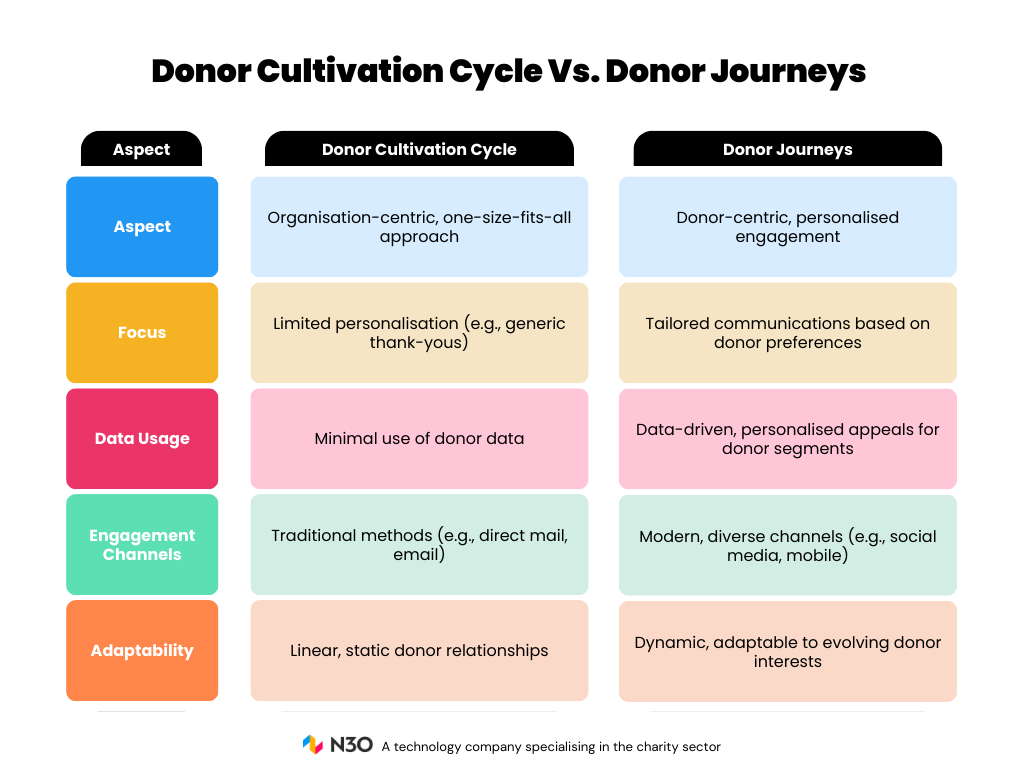
Donor Journeys Integrated Into the Donor Cultivation Cycle
Based on our earlier discussion, it is fair to say that the donor cultivation cycle is from the view of the Charity, while the donor journey is from the view of the donor.
The donor journey is generally seen from the donor’s perspective, focusing on their experience, motivations, and organisational interactions. It maps out how donors discover, engage with, and ultimately decide to support a charity.
In contrast, the donor cultivation cycle is typically viewed from the charity’s perspective. It outlines the steps an organisation takes to attract, nurture, and solicit donations from supporters. This cycle is more about the charity’s strategic approach to managing and developing donor relationships.
In summary:
- The Donor Cultivation Cycle provides a structured framework for nurturing donors.
- The Donor Journey offers insights into the donor’s perspective and experience.
By aligning these two concepts, nonprofits can optimise their donor engagement efforts and achieve greater success in fundraising and mission impact.
How do I get started?
Nonprofit fundraisers can start by building a donor journey map for their cause. The process doesn’t have to be complex. Start with a simple journey to grow and build from there.
Creating a donor journey map allows your fundraising team to visualise the donor’s path. You can gain a clear picture of where and how your donors connect with your organisation. This knowledge empowers you to identify fundraising strengths and weaknesses, further refining fundraising strategies.
Ally Smith of Fundraising KIT shares that your donor journey map should have three components:
- Giving stages
- Fundraising touchpoints
- Donor’s point of view (POV)
Image Credits: Showcase of Fundraising Innovation and Inspiration (SOFII)
Giving Stages
Giving stages are a simplified model of the donor journey. It’s important to note that the donor journey is not always linear. Donors may revisit previous stages, skip certain steps, or even become donors without extensive research. The key is to focus on progress and engagement rather than strict adherence to a predetermined path, says Ally Smith.
The overall objective is to move donors progressively through these stages, ultimately transforming them into loyal supporters. This process takes time and a deep understanding of donor motivations and needs. And would vary based on a charity and its mission. (To see how your charity can do this, look at the example of a ‘prospective Orphan Sponsor’s journey through the giving stages’ below)
By nurturing relationships and providing exceptional donor experiences, organisations can increase the likelihood of repeat giving and long-term commitment.
Note: The key for this process to work is to focus on your ideal donors. If you use it to push any donor that comes in contact with your charity, then your donor journey mapping won’t serve your fundraising goals, even if it is successful, because donors won’t stick to your charity long-term, and you will be stuck in acquiring new and new donors without building a loyal donor base.
So start this process by developing your ideal donor profiles.
Fundraising Touchpoints
Fundraising touchpoints are donors’ interactions with your organisation at each stage of their journey. To effectively nurture donors, it’s crucial to develop communications from their perspective. Let’s look at this throughout the five giving stages.
1. Awareness Stage
Donor Perspective: Potential donors are curious about your cause and organisation. They want to know what problem you’re solving and how. Example: A compelling Instagram post showing a video of your latest school-building project.
- Touchpoints: Social media ads, website traffic, earned media (news articles), events, direct mail, email campaigns.
2. Research Stage
Donor Perspective: Donors are exploring your organisation in depth. They want evidence of your impact and how their support can make a difference. Example: A detailed case study showcasing the success of your Microfinance project for women in Gambia.
- Touchpoints: Website content, blog posts, case studies, impact reports, free resources, webinars.
3. Decision Stage
Donor Perspective: Donors are considering whether to support your organisation. They want to feel confident in their decision and understand the impact of their gift. Example: A report highlighting the latest numbers of beneficiaries of your food security project in Asia.
- Touchpoints: Donation appeals, personalised emails, event invitations, volunteer opportunities, and matching gift programs.
4. Appreciation Stage
Donor Perspective: Donors want to feel valued and appreciated for their support. They want to know how their donation is making a difference. Example: A handwritten thank-you note accompanied by a small gift for a donor sponsoring an orphan in Pakistan.
- Touchpoints: Thank-you letters, personalised emails, donor recognition events, impact reports, beneficiary progress reports, and donor surveys.
5. Repeat Giving Stage
Donor Perspective: Donors want to feel connected to the organisation and its mission. They want to be recognised for their ongoing support. Example: An invitation to a donor-exclusive event with the organisation’s leadership.
- Touchpoints: Donor newsletters, stewardship reports, exclusive events, volunteer leadership opportunities, legacy giving programs.
Remember:
- Tailor your messages to the specific stage of the donor journey.
- Use data to understand your donors’ preferences and behaviours.
- Test different approaches to see what resonates best with your audience.
- Build strong relationships based on trust and transparency.
Donor’s Point of View
The heart of successful fundraising lies in truly understanding your donors. It’s not just about attracting new supporters; it’s about building lasting relationships that inspire continued giving. To achieve this, you must step into your donors’ shoes and view your organisation through their eyes.
How to develop a deep understanding of your donor’s POV?
- Define Your Audience: Clearly identify your target donor segments based on demographics, interests, giving history, and other relevant factors.
- Leverage Your CRM: Utilise your donor database to analyse your top supporters’ giving patterns, communication preferences, and engagement levels.
- Conduct In-Depth Interviews: Talk directly to your donors to uncover their motivations, challenges, and expectations.
- Track Donor Behavior: Monitor donor interactions with your organisation to identify trends and opportunities for improvement.
- Create Donor Personas: Develop fictional representations of your ideal donors to guide your marketing and fundraising efforts.
A donor persona typically includes detailed information about the ideal donor profile for a nonprofit organisation. It usually covers demographic information, psychographics, giving behavior, challenges and pain points, communication preferences, and more.
The infographic below offers a summarised version of a donor persona. A charity can make it as detailed as it likes.
A Prospective Orphan Sponsor’s POV at Each Stage – A Pragmatic Example
To understand the donor’s POV, let’s look at an example of a prospect who is interested in a charity’s orphan sponsorship program.
1. Awareness Stage
Goal: Become aware of the plight of orphans and potential solutions.
Thoughts: “I wonder how I can help children in need.” “I’ve heard about orphan sponsorship programs, but I don’t know much about them.”
Action: Browses social media, does web research, watches the news, and attends charity events.
Key steps this charity can take:
- Run engaging ads and campaigns highlighting the impact of sponsorship.
- Use emotional storytelling to connect with this potential donors
2. Research Stage
Goal: Learn more about the charity, its programs, and the impact of sponsorships.
Thoughts: “Is this charity reputable?” “How does their sponsorship program work?” “What kind of impact can I make with it?”
Action: Visits the charity website, reads reviews, searches for information online, contacts the charity for more details.
Key steps this charity can take:
- Provide a user-friendly website with detailed program information and child profiles.
- Include testimonials and impact reports to build trust and provide transparency.
3. Decision Stage
Goal: Decide whether to become a sponsor and commit to the program.
Thoughts: “Can I afford to be a sponsor?” “Will my sponsorship truly make a difference?” “Do I trust this charity?”
Action: Weighs the pros and cons, discusses with family or friends, and makes a final decision to sponsor or not.
Key steps this charity can take:
- Offer a straightforward sponsorship process with clear instructions.
- Send a confirmation email with personalised information about the sponsored child.
4. Appreciation Stage
Goal: Experience the impact of their sponsorship and feel a sense of fulfillment.
Thoughts: “I’m glad I decided to sponsor a child.” “It’s rewarding to know I’m making a difference.” “I want to learn more about my sponsored child.”
Action: Maintains communication with the charity, shares their experience with others, and potentially increases sponsorship level.
Key steps this charity can take:
- Send a thank-you package with a personal letter and photos.
- Provide regular updates and progress reports about the child and the program.
5. Repeat Giving Stage
Goal: Continue supporting the child and the charity’s mission.
Thoughts: “I want to continue making a difference in my sponsored child’s life.” “I believe in the charity’s work and want to support it further.”
Action: Renews sponsorship, increases sponsorship amount, becomes a monthly donor or advocates for the charity.
Key steps this charity can take:
- Maintain ongoing communication with impact updates, and success stories, and continue to acknowledge & recognise their support.
- Offer opportunities to sponsor additional children or increase support.
Now, if we combine all three components of this donor journey as discussed, here’s what it will look like.
The end result is a comprehensive, data-driven fundraising strategy that maximises donor engagement and lifetime value.
Dedicate your time to developing this donor journey map because it’ll help you achieve your fundraising goals. A charity will need to develop multiple donor journey maps for each of its different fundraising projects, as each would resonate with a different donor audience.
